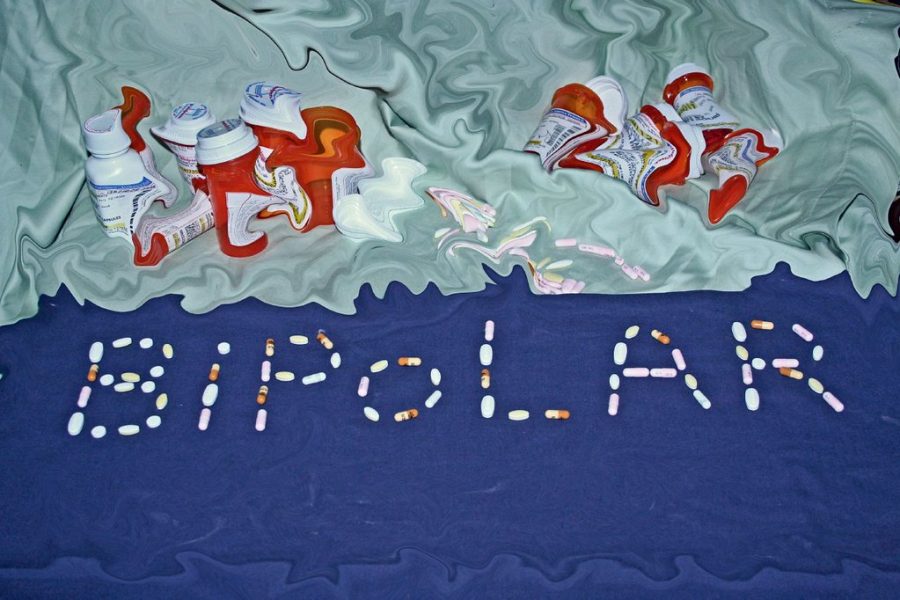*Names changed for anonymity
Bipolar disorder is characterized by extreme shifts in mood. These shifts are often cyclical, including episodes of depression and mania lasting anywhere between hours and months. According to the Mayo Clinic, depressive episodes may include symptoms such as low energy, low motivation and loss of interest in daily activities, and manic episodes may include high energy, reduced need for sleep and loss of touch with reality.
Senior Amelia Faust* was recently diagnosed with bipolar disorder. According to Faust, depressive and manic episodes look different in different people and often manifest in unexpected ways.
“I have depressive episodes where I can’t get out of bed,” Faust said. “I don’t feel sad when I’m in a depressive state—I just don’t take care of myself well. I struggle to complete my homework.”
Like many other mental illnesses, diagnosis provides many benefits. It offers patients a new lens while opening up opportunities for treatment. But according to school psychologist Jennifer Zacharski, psychiatrists often shy away from diagnosing bipolar disorder. The similarities between depressive episodes and depression make misdiagnosis commonplace, especially among adolescents.
“I was originally diagnosed with depression,” Faust said. “I felt really hopeless because I was on medication that wasn’t helping me. I think that getting diagnosed properly and being put on the right medication made me feel more hopeful.”
There are two main subtypes of bipolar disorder: bipolar 1 and bipolar 2. Bipolar 1 involves more intense manic episodes, while bipolar 2 involves more frequent depressive episodes. Both subtypes are treated using similar methods: medication and therapy.
“The two main types of therapy are cognitive behavioral therapy and dialectic behavioral therapy,” Zacharski said. “Cognitive behavioral therapy gives you exercises to reframe and retrain your brain. Dialectic behavioral therapy teaches you how to make better decisions during stressful times.”
Bipolar disorder often impacts more than the person who has it—when left undiagnosed, its instability can affect close friends and family members as well. Sophomore Abigail Johanssen* grew up with a mother with bipolar disorder. According to Johanssen, her mother’s unstable moods prior to treatment influence her own perceptions and relationships.
“Your whole life, you see your parent as an example,” Johanssen said. “You see their behaviors and your relationship as normal, whether that is true or not. I think it definitely had an impact on me.”
Living with someone with bipolar disorder creates a unique set of implications. Zacharski encourages anyone who lives with someone with bipolar disorder to reach out to a counselor, therapist or school psychologist to gain a better understanding of these challenges.
“Your environment is unpredictable,” Zacharski said. “You should reach out to a clinician to help you reframe what’s going on with the person you love.”
According to Zacharski, when treated, those diagnosed with bipolar disorder can live without being significantly impacted by their disorder. Research and consulting with professionals when needed provides a better understanding—a key step toward removing stigma.
“I think that people assume bipolar disorder is way more impairing than anxiety or depression,” Johanssen said. “If people knew that, in reality, it’s not always as intense as they think, they would understand it better.”
This story was originally published on The Charger on March 12, 2021.






























![IN THE SPOTLIGHT: Junior Zalie Mann performs “I Love to Cry at Weddings,” an ensemble piece from the fall musical Sweet Charity, to prospective students during the Fine Arts Showcase on Wednesday, Nov. 8. The showcase is a compilation of performances and demonstrations from each fine arts strand offered at McCallum. This show is put on so that prospective students can see if they are interested in joining an academy or major.
Sweet Charity originally ran the weekends of Sept. 28 and Oct. 8, but made a comeback for the Fine Arts Showcase.
“[Being at the front in the spotlight] is my favorite part of the whole dance, so I was super happy to be on stage performing and smiling at the audience,” Mann said.
Mann performed in both the musical theatre performance and dance excerpt “Ethereal,” a contemporary piece choreographed by the new dance director Terrance Carson, in the showcase. With also being a dance ambassador, Mann got to talk about what MAC dance is, her experience and answer any questions the aspiring arts majors and their parents may have.
Caption by Maya Tackett.](https://bestofsno.com/wp-content/uploads/2024/02/53321803427_47cd17fe70_o-1-1200x800.jpg)
![SPREADING THE JOY: Sophomore Chim Becker poses with sophomores Cozbi Sims and Lou Davidson while manning a table at the Hispanic Heritage treat day during lunch of Sept 28. Becker is a part of the students of color alliance, who put together the activity to raise money for their club.
“It [the stand] was really fun because McCallum has a lot of latino kids,” Becker said. “And I think it was nice that I could share the stuff that I usually just have at home with people who have never tried it before.”
Becker recognizes the importance of celebrating Hispanic heritage at Mac.
“I think its important to celebrate,” Becker said. “Because our culture is awesome and super cool, and everybody should be able to learn about other cultures of the world.”
Caption by JoJo Barnard.](https://bestofsno.com/wp-content/uploads/2024/01/53221601352_4127a81c41_o-1200x675.jpg)






